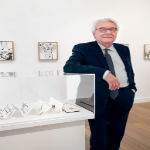TRANSLATED FROM THE FRENCH BY JOHN TAYLOR
His sincere humility allowed no one to dare ask him to comply and let himself be portrayed. With the years, moreover, the abbot had become feeble; he rarely left the infirmary or received visitors. This is how the young Duke of Saint-Simon describes it at the beginning of his Memoirs. The abbot, whom he merely calls Monsieur de La Trappe, is none other than Armand-Jean Bouthillier de Rancé, “the perfect mirror of penitence” according to Chateaubriand.
Saint-Simon was twenty-one, Rancé fifty years more than that. The duke had married young and was already a father. Three years earlier, he had bought the Royal Carabiniers Regiment and lay siege to Namur. He then planned to wed the daughter of his friend, the Duke of Beauvilliers. It is to La Trappe that he went to seek consolation when this project failed. In 1695, the king confirms the reforms that Rancé brought to La Trappe. “I went to rejoice with Monsieur de La Trappe,” said the duke, “about the solidity just granted by the King to what he had undertaken.” At the age of seventy-one, Rancé, who was weary and desired an ascetic retirement to prepare himself for death, sends his resignation to the king and names a successor. “When he stepped down,’ writes Saint-Simon, ‘he came forth as even greater in this new state than he had been during the reform and governance of his admirable monastery.”
The young man’s attachment to and admiration for the prior made him wish to possess his portrait. He wanted to perpetuate, through a likeness, the spirit of the saintly man in the same way that his books perpetuated his thinking. Books which, furthermore, without Bossuet’s friendly insistence, the modest man would never have dreamt of making public.
In 1696, Hyacinthe Rigaud, a native of Perpignan, was only thirty-seven years old. He had not yet painted the king and his family, but he had already received the Prix de Rome from Colbert’s hands. Charles Le Brun, the king’s official painter, had dissuaded Rigaud from making the journey to Rome so that he could abandon history painting and devote himself wholly to portraiture, the genre in which he excelled. Saint-Simon says of him that he was, at the time, the best artist in Europe for obtaining the likeness of a human beings as well as strong, lasting paint.
How could the most renowned painter of the day be persuaded to make the portrait of an old invalid who lived a reclusive life in an abbey in the depths of Orne and who aspired only to silence and meditation?
A thousand ecus sufficed. However, it was still necessary to come up with an entire scheme for outwitting the reticent model.
Saint-Simon convinced the painter to accompany him to La Trappe and pretend to be an officer, from among his friends, who so deeply admired the abbot that he dreamt of meeting him. The painter would merely have to observe intensely the Trappist to see through his facial features and make of them a portrait from memory. Beyond the ecus, it was perhaps the difficulty of the task that urged the artist to play the game.
However, as it happened, Rigaud was a great stutterer (except, it seems, when he sang, but La Trappe was no place for singing). The two accomplices agreed to take advantage of this defect.
Saint-Simon obtained an audience for himself and his officer-friend. Rigaud stammered a few words of thanks and excuse, then stopped speaking. The duke explained that his friend’s impediment prevented him from participating in the conversation but that he would be delighted simply to see and listen to a man whom he admired so much and that he would make up for his infirmity by doubling his attention as he was looking on.
The small room, near the infirmary, in which Rancé received the two men had, Saint-Simon tells us, light coming in from two sides, only white walls with a few pious prints, and straw seats. As for the light, Rigaud found the room as suitable as could be wished for. The Father Abbot, wearing his cassock, was sitting at the desk on which he had written all his books. A large handwritten notebook lay in front of him. On the desk were a few bound books and a skull. The interview lasted three-fourths of an hour. Rancé perceived nothing, lamenting only that the officer, who was feasting his eyes on him, suffered from this speech impairment.
The interview had barely ended when the painter rushed to his sketchbook to put down immediately, before they faded, the facial features he had memorized. He set them down from all the angles with which the conversation had provided him, depending on whether the abbot looked at the duke or the false-officer or withdrew inside himself and gazed at no one. There will be time, before executing the portrait, to choose the ideal pose.
However, this was not yet enough. Rigaud demanded two and then three more meetings, to which Rancé acquiesced, not without annoyance and upon the pledge that this would be the last time. The painter swore that a mere half-hour would suffice to finalize his vision. He kept his promise, Saint-Simon says, and withdrew even before the half-hour had elapsed. When he had gone outside, Saint-Simon continues, Monsieur de La Trappe expressed his surprise at having been scrutinized so thoroughly and for such a long time by this sort of speechless man.
Rigaud worked during the rest of the day as well as the next day. He made a portrait as resemblant as if the model had long sat for him. The gentleness, the serenity, the majesty of the face; the lively, piercing, noble, fiery eyes, so difficult to render; the finesse and the grandeur expressed by the physiognomy; that candor, that wisdom, that inner peace of a man who possesses his soul—all this was rendered, notes Saint-Simon, as well as the grace that had by no means left this face exhausted by penitence, old age, and suffering.
The next day, a monk sat at Rancé’s desk so that the painter’s pencil could capture the posture, the clothing, and the desk itself. Finally, back in his studio, Rigaud transposed everything onto a large canvas and incorporated the memorized facial features. This is how was born the stolen portrait of Monsieur de La Trappe by Hyacinthe Rigaud.
Also, read The Poodle and The Christ Child by Jean Frémon, Translated from The French by John Taylor and published in The Antonym:
Follow The Antonym’s Facebook page and Instagram account for more content and interesting updates.




























0 Comments